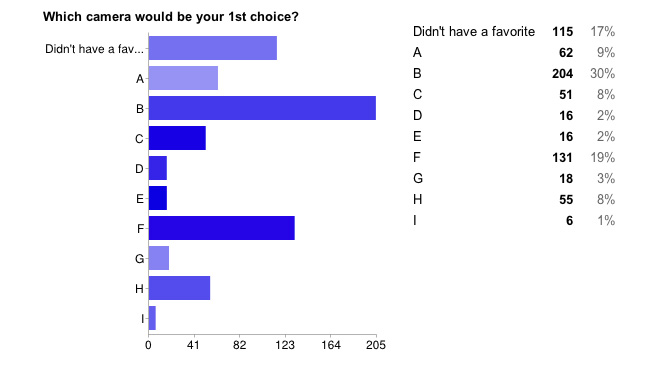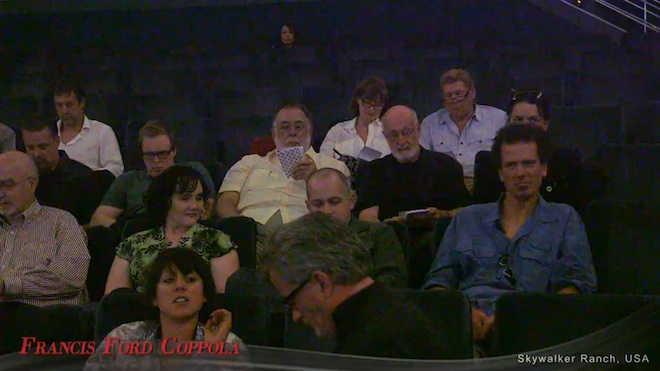
Francis Ford Coppola gives his answer in the new Zacuto Shootout, choosing in order of preference the Panasonic GH2 (lit by Colt Seaman), Alexa and Epic
Get the most from the GH2 – Read the EOSHD GH2 Shooter’s Guide
The results are in from Zacuto’s Revenge Of The Great Camera Shootout 2012. The majority of those at the cinema screenings – including Francis Ford Coppola preferred Colt Seaman’s lighting and the capturing of it by the Panasonic GH2.
This choice was above the stiffest possible competition including the Sony F65, Red Epic, Canon C300 and Arri Alexa. There’s a comment from Part 2 which really stands out for me and it sums up the reason EOSHD and my passion to write my GH2 book and the blog exists –
“The thing I was most impressed with is that some guys or gals with something to prove did better at lighting than the established cinematographers with a good camera” – Bruce Lundeen (33 min 13 seconds)
This is how you make a great film, a great shot, a great scene – Passion, hunger, creativity and a $700 camera.
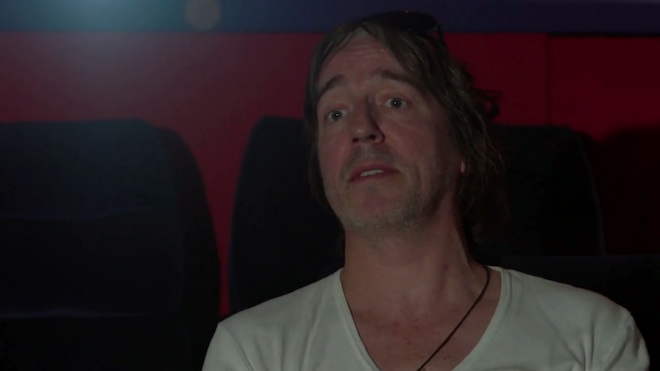
Nick Driftwood who provided the settings for the GH2 hack on the shootout
Spoiler alert! If you haven’t yet – I recommend seeing Part 2 at Zacuto here before going further
Zacuto’s anonymously labeled comparison has now been outed. For digital theatre screenings in 2k or 1080p, extremely high end cameras simply don’t look that much different to the lower end ones. It is therefore the lighting and the skill behind the camera that makes a larger percentage of the difference. As the level of skill involved here behind the camera was all very high, each scene was similar but the GH2 was still able to overcome the F65 or Epic, mainly because –
A) It was handled better
B) The lighting was most creative
C) The technology inside the GH2 was advanced enough to deliver on this shoot relative to a $70,000 F65
Now this to me is amazing and not just the fact that talent is what matters. This is obvious! I feel Zacuto’s film tends to concentrate on the latter and rather glosses over the former. But both messages are important for me.
The reason EOSHD came to be at the start of the DSLR revolution was because I believed back then, and still do now, that the tools you need to create stunning looking cinematography are now available for under $1000. This is my philosophy and I’m sticking to it.
Money – especially not on the camera side – should not prevent people from discovering their talent, learning their craft and capturing their vision as a cinematographer or filmmaker.
That talent can overcome adversity is the message of Zacuto’s Revenge so far. But less obvious to many is just how good the GH2 is as a digital cinema tool. For me as a tech fan as well as a cinematographer it is just as exciting as the talent that goes behind it. This comparison also helped reinforce my point that the 7D is an absolute let down, that when shot with against the GH2 it noticeably falls apart with a soft image with moire and aliasing in abundance. Again you can overcome the shortcomings of Canon DSLRs with skill… But since the GH2 is just $700 why waste your money on a camera that costs more but delivers less? It pains me for the situation to be as it is but in my opinion Canon have failed in every way since the fantastic 5D Mark II all those years ago, with the exception of the $15,000 end of the market which is out of many people’s reach. It continues to be the case, that Canon have fallen short on image quality in video mode on their DSLRs relative to Panasonic. They have major questions to answer. I am sure Tim Smith in the Zacuto screening was trying to put a positive spin on things, and good luck to him.
The DSLR revolution is not dead but Canon tried to kill it.
The results… Part 2 Spoilers beyond this point
When will the dynamic range obsession end?
The big mistake the FS100, F3 and C300 team made on this shoot was to try and show off the dynamic range of the cameras. More dynamic range does not always make for a better looking image. It is there to give you more choices in post – “Do I save the highlights here, and bring up the shadows there?”
The lighting for the C300 and FS100 in particular was unbelievably muddy. Considering there was a huge window at the back, to try and trick the viewer’s eye into thinking the interior would look like a 10pm dinner party with that kind of backdrop is too far a stretch. Which leads us to a big lesson for all filmmakers – don’t insult the audience’s sense of realism, especially not in a flat and boring way. Surrealism is fine if it is imaginative and purposeful, but flat falseness breaks the all important suspension of disbelief.
No surprises, please
Judging from the audience reaction the Zacuto shootout, the results were a little surprising – unless you are a GH2 shooter. Pair it with the right lenses, the right lighting, the right subject and most importantly the right cinematographer and director – and those who use this camera seriously and not just as a one off know that the end result will look as good as Hollywood. In fact there’s very little reason why the image from a $15,000 camera like the C300, Sony F3 is any better – it is just specs – and as we’ve seen, specs are so often meaningless.
It is the optimal end result which matters.
Speaking of optimal – the RED Epic was somewhat hamstrung in this test by not being able to stretch its 5K legs and similarly the Arri Alexa did not get a very stern test from the internal studio lighting setup. Had the screening been 4K it would be obvious that the F65 and Epic would be number 1 and 2 respectively because they’d stand out. With all else equal resolution makes an image ‘pop’, just like great colour and contrast does. Today both the Alexa and Epic (and soon the F65) are Hollywood gold standards and they give you more creative choice in post, as well as delivering better resolution than any of the other cameras in the test apart from the Sony F65. The F65 did stand out for me – because it reminded me most of film.
Specifically the silky silver screen Kodak look of Hitchcock.
Sure the highlights were pink, which was a slight worry because that implies the green channel clips before red and blue – but I am sure that issue was specific to the shoot and not a general problem with the camera. It had a superior colour gamut to the the Epic.
In the end, in those conditions, the GH2 could mix it with the very best. A $700 consumer camera versus a $70,000 Sony F65 – and most people watching in a theatre (let alone on the web) chose ‘B’ including Francis Ford Coppola. That is the fact of the matter. And I know many people with their hopes and dreams invested in high end gear might have a hard time swallowing that.
Here are my original thoughts, and how they transpired in Part 2. I won’t pull any punches in my analysis and comments here, so if you were the person responsible for the lighting and camera on the test please do not take my views personally. It is only my opinion of an image, not you. This one single test is not meant as a career critique and should not be taken to heart!
Camera A – Sony F3 – Nancy Schreiber ASC
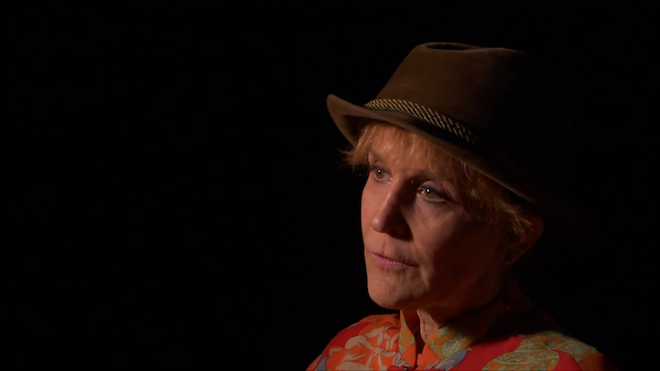
How I saw it blind
A bit muddy, didn’t like the low contrast, the lower colour temperature or the slight shift to yellow. A bit metallic looking and not as emotionally satisfying as B or C.
The camera and crew
Low contrast = trying to maximise dynamic range. Don’t do it, it looks shit. There’s a prime example of this and it is the new Sony compact, the RX100. Try taking a still in low light at ISO 3200 – the shadows are there – but they look grey and noisy. The colour is there but it looks muted. Now switch to Handheld Twilight Mode. This layers 6 stills on top of one another to enhance tonality. The ramp from low to high is steeper, but more dynamic. The blacks are crushed – it enhances contrast and the atmosphere. It is the night after all. Tonality is rich and velvety, the noise is gone. And that leads me to…
Camera B – Panasonic GH2 – Colt Seaman
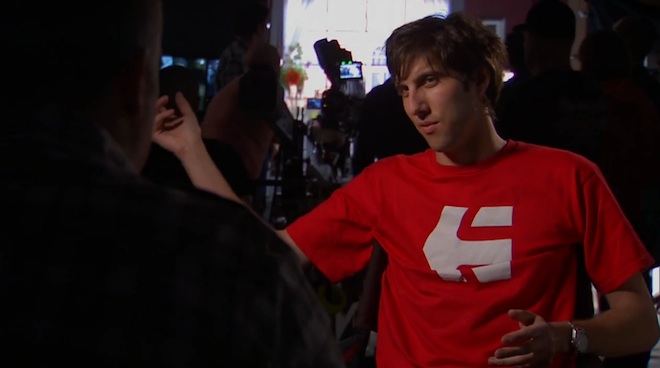
Colt Seaman – lead GH2 cinematographer on the Zacuto shootout 2012
How I Saw It Blind
Much better, loved the colour, plenty of detail in the blacks. Actors no longer in the shade. Highlights in window only weak point but preferred the warmer colour tone. The only negative is that this shot looked a little bit plastic and not quite as understated as others.
The Camera and Crew
Sometimes to crush the blacks makes what detail you still have in the lows more noticeable. A greater contrast and a greater tonality. Colt’s best move here was to increase fill lighting to bring up detail in the blacks but the colourist and camera maintained a punchy high contrast to the image. They didn’t bring down saturation, and went for a warm feel which suited the scene. It was a party, people mingling, it should be warm. The cinematographers who went for a cool white balance made a terrible error. Always match the way the scene is written to how it appears on screen. The only con was a slightly staged look to the woman standing centre-right. Her legs look plastic. Skin tone is not the GH2’s strong suit because it does tend to have a slightly yellow cast to pink due to the sensor. It is subtle, but it is there. Did it hurt the image on this occasion? Not very much. Could it be something to watch out for? Yes. And that is why you read the tech blogs! One thing I would like to see in the GH3 is a more Sony-like sensor when it comes to skin tones, velvety reds and deep oranges.
Camera C – Red Epic – Ryan Walters

How I Saw It Blind
Great detail on the wide shot at the start, of the table near the window, visibly more than Camera A. Very nice all rounder with no real flaws. F65? Alexa?
The Camera and Crew
Do you know why people tend to capitalise RED and EPIC? It is because Jim Jannard is a capital letters kind of guy. I have found this through personal experience. Do I admire the capital letters approach? Yes I do actually. Did I admire the treatment of the Epic in this test? Not so much. There’s zero mention, zero disclaimer, that this is a 4K fish swimming in a 2K pool. Resolution, along with colour, is one of the biggest things a camera brings to the shoot. Had this been screened in 4K people’s minds would have been made up. What this does show however, is that 99% of today’s audience do not care about 4K. They will do in the future so be prepared.
Camera D – Apple iPhone 4S – Michael Koerbel
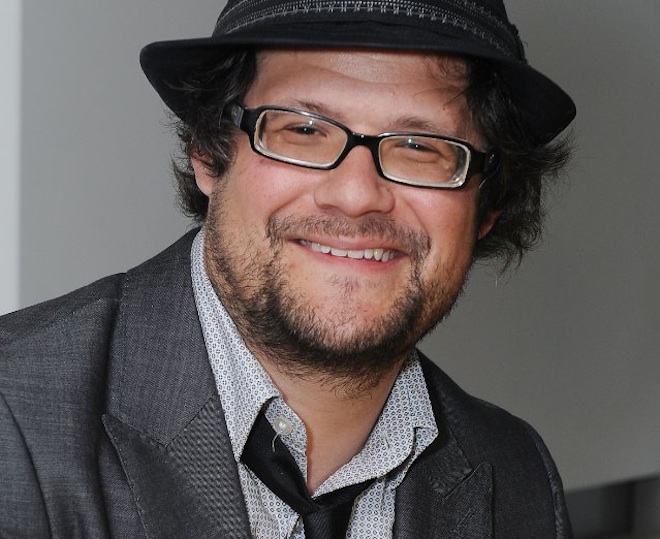
How I Saw It Blind
One that visibly falls short even on the web. A very soft image to begin with, improved on close-up. Didn’t like the artefacts on edges of highlights, but cinematographer did a great job squeezing the dynamic range in the scene to fit. I think this was the iPhone shot and the size of the bokeh / deep depth of field is pretty telling due to the small sensor.
The Camera and Crew
Michael did a superb job here. We’re talking about a *telephone* whose flaw is to lack dynamic range and shallow depth of field because of a sensor that is sized down to match the razor edge of the iPhone’s profile. No great technological shame in that, rather quite the opposite. The iPhone still trumps the 7D in the resolution stakes, and doesn’t suffer from as much moire or aliasing. I only wish visionary Steve Jobs was still alive to see the results as he’d be proud.
The iPhone scene in this shootout is actually one of the most telling. What was missing was a depth of field control (a shallow separation between actors and backdrop) and 24p. The small sensor and lack of 24p crippled the image, but the other stuff didn’t as much. That tells you that in a controlled studio environment like this you can adjust the lighting to match the dynamic range you have available in the camera, and that 15+ stops of dynamic range is god damn overrated.
Camera E – Canon C300 – Polly Morgan
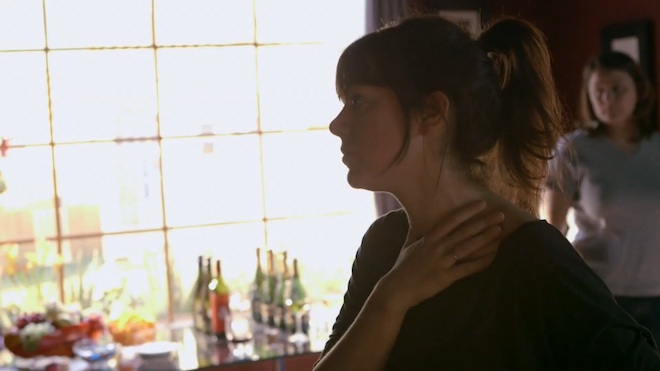
How I Saw It Blind
No major weaknesses in this image, camera wise (apart from some aliasing on the high contrast edge of the lamp shade), good detail. But the lighting is a little murky (shadowy actors again) and colour temperature isn’t warm enough for my tastes. I’d say this was the FS100.
The Camera and Crew
If I am being blunt and honest here – I am so please humour me – this was an uninspired shoot to say the least, with the actors in the shade and their grey hair as a result. The camera has no real flaws because Canon set out to make a ‘very good 1080p’ camera. That $15,000 does not however give you a magic wand over a $700 GH2. It makes your life easier with a built in ND filter and an image which you’d expect not to have any flaws for that amount of money. It also has a rather nice form factor which dumps the traditional camcorder shape where it belongs, in the bin. But you don’t pay for a leap in image quality, you pay for convenience. As far as the lighting and set up of the scene goes in the shootout I do wonder what the C300 team was doing. Cinematography may be first and foremost a skill of aesthetic judgement but it is also a technical discipline too. Sadly I feel Polly was uninspired in the former and uneducated in the latter, from the very small slice of her work I see here! It didn’t please my inner geek that in her Part 2 soundbite she didn’t recognise how to spot the 7D in the shootout, with all that moire and softness – and if one doesn’t know the difference between Canon DSLR footage and F65, clearly one’s technology knowledge is not as broad as it could be.
Camera F – Arri Alexa – Rodney Charters
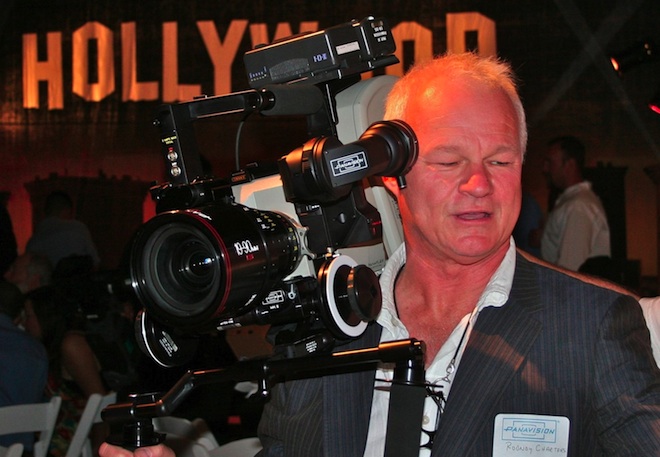
How I Saw It Blind
Nice warm colour balance, outside area looked superb on this shot. Hard to tell via web but could be the Alexa or maybe the Epic? Certainly a lot of dynamic range on display here.
The Camera and Crew
Looking at this again it does feel very 24. Rodney has a pretty unique style and he brings it with him when he arrives on set. Although this scene ended up being more muted in terms of contrast and colour than the GH2, if the scene was more challenging it would have won out. There are no real flaws in this one. I loved Drive, which was shot on the Alexa and I love Arri’s purist no-compromise approach to digital cinema cameras. We didn’t see a strenuous test of the Alexa technology in this instance so what you’re seeing, especially via Vimeo is rather the Alexa and Rodney Charters on a leash.
Camera G – Canon 7D – Michael Negrin ASC
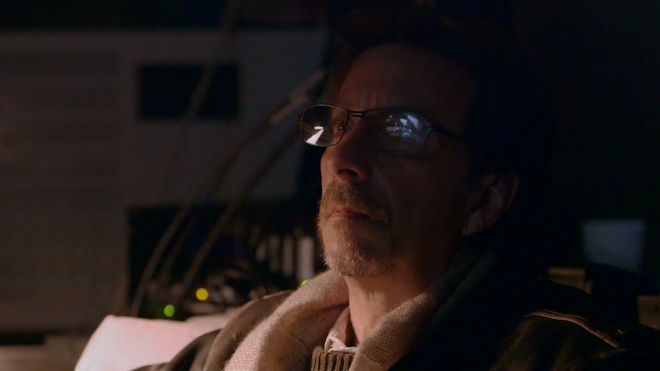
How I Saw It Blind
The problem with this scene is that the lighting inside is unrealistically dim given the huge window and bright outdoor sunlight streaming through the window. This fixed nothing because somehow both the highlights are blown and the set is too dark. In my opinion this scene looks worse than the iPhone because it isn’t naturally lit. A few give away signs on this are the moire on the lamp and window frame. Blown highlights and muddy shadow detail. If I was being cruel to Canon, like I often am, I’d say this was the dated old 7D and not particularly well handled either. Sorry! But that is how I saw it.
The Camera and Crew
Michael did a poor job lighting, as did the camera in capturing it. This isn’t my opinion, it is a fact. This isn’t unexpected, it is high time for Canon to get their act together in the huge sub $15,000 video market, because I am really pissed off with them right now and their complete failure to give me what I need, be it at $1000, $3000, $6000 or even $10,000.
Camera H – Sony F65 – Sony Approved Cinematographer
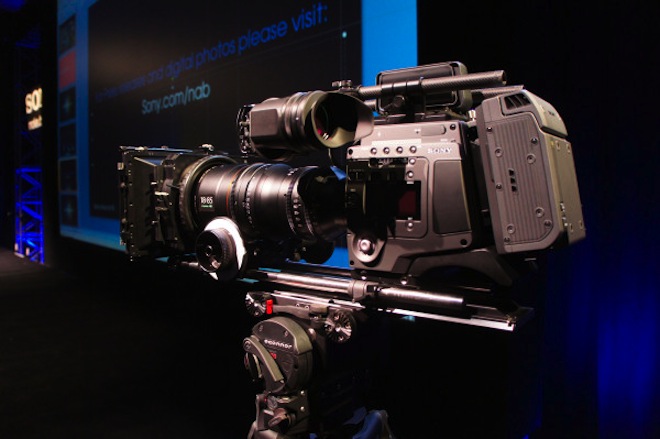
How I Saw It Blind
Stands out. Not as natural looking as camera C but pretty damned good. Nice dynamic range, but not as flat as some – satisfyingly punchy and contrast image with good tonality. Moody lighting added dramatic ‘Hitchcockian’ feel. Colour slightly unnatural but again reminds me of Rear Window film-like earlier Technicolor look. Certainly get the affect of the sun streaming through the window onto the floor with this scene. To me this reminds me most of the GH2 with is a superb camera if you know how to work around its limitations.
The Camera and Crew
The anonymous corporate team behind this shoot did not change any lighting. That the camera was able to stand out regardless is a testimate to how the F65 is possibly the best digital cinema camera in the world today. For me, it simply looks the most like film – the highest compliment of all. Yet it has none of the drawbacks of film like noisy high sensitivity, expensive processing and the soon to be unavailable non-digital media. If I was to choose my ultimate camera right now, money no object, then it would be this one.
Camera I – Sony FS100 – Den Lennie & Mick Jones
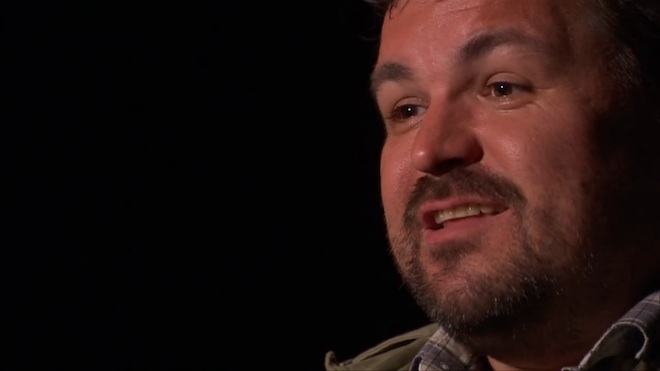
How I Saw It Blind
Although the roll off was nice on the guy’s red shirt near the window this is the third scene in the test with some aliasing and murky colour. Also the window frame looks distracting for some reason when the focus rack occurs, not a nice roll off in the highlights. No super-white, clearly someone trying to protect the highlights but it doesn’t help the overall image, better to have more contrast BUT the main reason I didn’t like this scene as much as others was down to the lighting not the camera setup. Fill lighting should have been brought up far more, to match large window and brightness of outdoor lighting. All the actors are in shade!
The Camera and Crew
Nearly everything aesthetic about this scene is wrong. The lighting is off. There’s zero technical reason why the audience should not have chosen the FS100 as a favourite (as they did the GH2). Tonal range in this scene was heavily compressed, especially in the highs which lead to an ugly fiasco in the window where the window frame appears unreal and distracting. I have to say that the FS100 team did not get the best from that camera, for whatever reason, on this occasion. It is not the camera’s fault. Den Lennie was talking about maximising the 8 bit codec on the FS100. But he’s maximised it all for one thing – dynamic range. Doing so comes at the expense of tonality, highlight roll off, contrast and so many other things. This is why I don’t use CineStyle on DSLRs and it is why I don’t shoot flat on the FS100. In fact I’m not a big fan of extremely flat picture profiles unless you’re shooting raw, because the extended dynamic range and muted colour comes at the expense of the amount of sensor data captured. When you are baking a lack of colour and contrast into AVCHD it is dangerous, because you need to bring it back in post and you are reconstructing data that isn’t actually there. Fixing something is never as good as working with something which isn’t broken in the first place so please can we have an end to this obsession with shooting LOG on a compressed recording format like AVCHD. It is an absolute nonsense. By all means flatten the image a little bit but not an extreme flat profile!
And finally…
Compare the results to the blind ‘taste test’ below conducted by No Film School. Here’s what the masses had to say about their favourite image of the Shootout. It goes GH2 with 30% of the vote, followed by Alexa with 19% with the others failing to register above 9%.
Read my thoughts on Part 1 here
